Analysis of Research Topics and Scientific Collaborations in Renewable Energy Using Community Detection
Abstract
:1. Introduction
2. Materials and Methods
2.1. Retrieving Information Using Automated Scripts
2.2. Community Detection
2.3. Comparison with Other Approaches
3. Results and Discussion
3.1. Trending Topics in Renewable Energy
3.2. Type of Publication
3.3. Authors, Affiliations, and Countries in Renewable Energy
4. Conclusions
Author Contributions
Funding
Conflicts of Interest
References
- British-Petroleum. BP Statistical Review of World Energy 2016. 2017. Available online: http://www.bp.com/statisticalreview (accessed on 10 November 2018).
- Manzano-Agugliaro, F.; Taher, M.; Zapata-Sierra, A.; Juaidi, A.; Montoya, F.G. An overview of research and energy evolution for small hydropower in Europe. Renew. Sustain. Energy Rev. 2017, 75, 476–489. [Google Scholar] [CrossRef]
- Irandoustm, M. The renewable energy-growth nexus with carbon emissions and technological innovation: Evidence from the Nordic countries. Ecol. Indic. 2016, 69, 118–125. [Google Scholar] [CrossRef]
- Abdmouleh, Z.; Gastli, A.; Ben-Brahim, L.; Haouari, M.; Al-Emadi, N.A. Review of optimization techniques applied for the integration of distributed generation from renewable energy sources. Renew. Energy 2017, 113, 266–280. [Google Scholar] [CrossRef]
- Momirlan, M.; Veziroglu, T.N. The properties of hydrogen as fuel tomorrow in sustainable energy system for a cleaner planet. Int. J. Hydrog. Energy 2005, 30, 795–802. [Google Scholar] [CrossRef]
- Kılkış, B.; Kılkış, Ş. Hydrogen Economy Model for Nearly Net-Zero Cities with Exergy Rationale and Energy-Water Nexus. Energies 2018, 11, 1226. [Google Scholar] [CrossRef]
- Ajanovic, A.; Haas, R. Economic prospects and policy framework for hydrogen as fuel in the transport sector. Energy Policy 2018, 123, 280–288. [Google Scholar] [CrossRef]
- Danilov, N.; Lyagaeva, J.; Vdovin, G.; Pikalova, E.; Medvedev, D. Electricity/hydrogen conversion by the means of a protonic ceramic electrolysis cell with Nd2NiO4+Δ-based oxygen electrode. Energy Conv. Manag. 2018, 172, 129–137. [Google Scholar] [CrossRef]
- Rodríguez Matienzo, J.M. Influence of addition of hydrogen produced on board in the performance of a stationary diesel engine. Int. J. Hydrog. Energy 2018, 43, 17889–17897. [Google Scholar] [CrossRef]
- Mazloomi, K.; Sulaiman, N.B.; Moayedi, H. Electrical efficiency of electrolytic hydrogen production. Int. J. Electrochem. Sci. 2012, 7, 3314–3326. [Google Scholar]
- Fischer, C.; Greaker, M.; Rosendahl, K.E. Strategic technology policy as a supplement to renewable energy standards. Resour. Energy Econ. 2018, 51, 84–98. [Google Scholar] [CrossRef] [Green Version]
- Karytsas, S.; Theodoropoulou, H. Socioeconomic and demographic factors that influence publics’ awareness on the different forms of renewable energy sources. Renew. Energy 2014, 71, 480–485. [Google Scholar] [CrossRef]
- Wüstenhagen, R.; Wolsink, M.; Bürer, M.J. Social acceptance of renewable energy innovation: An introduction to the concept. Energy Policy 2007, 35, 2683–2691. [Google Scholar] [CrossRef] [Green Version]
- Blazquez, J.; Fuentes-Bracamontes, R.; Bollino, C.A.; Nezamuddin, N. The renewable energy policy Paradox. Renew. Sustain. Energy Rev. 2018, 82, 1–5. [Google Scholar] [CrossRef]
- Afonso, T.L.; Marques, A.C.; Fuinhas, J.A. Strategies to make renewable energy sources compatible with economic grow. Energy Strateg. Rev. 2017, 18, 121–126. [Google Scholar] [CrossRef]
- Karunathilake, H.; Perera, P.; Ruparathna, R.; Hewage, K.; Sadiq, R. Renewable energy integration into community energy systems: A case study of new urban residential development. J. Clean. Prod. 2018, 173, 292–307. [Google Scholar] [CrossRef]
- Baños, R.; Manzano-Agugliaro, F.; Montoya, F.G.; Gil, C.; Alcayde, A.; Gómez, J. Optimization methods applied to renewable and sustainable energy: A review. Renew. Sustain. Energy Rev. 2011, 15, 1753–1766. [Google Scholar] [CrossRef]
- Iqbal, M.; Azam, M.; Naeem, M.; Khwaja, A.S.; Anpalagan, A. Optimization classification, algorithms and tools for renewable energy: A review. Renew. Sustain. Energy Rev. 2014, 39, 640–654. [Google Scholar] [CrossRef]
- Newman, M.E. Coauthorship networks and patterns of scientific collaboration. Proc. Natl. Acad. Sci. USA 2004, 101, 5200–5205. [Google Scholar] [CrossRef] [PubMed] [Green Version]
- Leskovec, J.; Lang, K.J.; Dasgupta, A.; Mahoney, M.W. Community structure in large networks: Natural cluster sizes and the absence of large well-defined clusters. Internet Math. 2009, 6, 29–123. [Google Scholar] [CrossRef]
- Tang, L.; Liu, H. Community detection and mining in social media. Synth. Lect. Data Min. Knowl. Discov. 2010, 2, 1–137. [Google Scholar] [CrossRef]
- Chadegani, A.A.; Salehi, H.; Yunus, M.M.; Farhadi, H.; Fooladi, M.; Farhadi, M.; Ale Ebrahim, N.A. comparison between two main academic literature collections: Web of Science and Scopus databases. Asian Soc. Sci. 2013, 9, 18–26. [Google Scholar] [CrossRef]
- de la Cruz-Lovera, C.; Perea-Moreno, A.-J.; de la Cruz-Fernández, J.-L.; Alvarez-Bermejo, J.A.; Manzano-Agugliaro, F. Worldwide Research on Energy Efficiency and Sustainability in Public Buildings. Sustainability 2017, 9, 1294. [Google Scholar] [CrossRef]
- Perea-Moreno, M.-A.; Hernandez-Escobedo, Q.; Perea-Moreno, A.-J. Renewable Energy in Urban Areas: Worldwide Research Trends. Energies 2018, 11, 577. [Google Scholar] [CrossRef]
- Montoya, F.G.; Alcayde, A.; Baños, R.; Manzano-Agugliaro, F. A fast method for identifying worldwide scientific collaborations using the Scopus database. Telemat. Inform. 2018, 35, 168–185. [Google Scholar] [CrossRef]
- JSON 2018. Available online: http://www.json.org (accessed on 20 November 2018).
- Franceschini, F.; Maisano, D.; Mastrogiacomo, L. Empirical analysis and classification of database errors in Scopus and Web of Science. J. Informetr. 2016, 10, 933–953. [Google Scholar] [CrossRef]
- OpenRefine 2018. Available online: http://openrefine.org/ (accessed on 20 November 2018).
- Fortunato, S. Community detection in graphs. Phys. Rep. 2010, 486, 75–174. [Google Scholar] [CrossRef] [Green Version]
- Yan, E.; Ding, Y.; Milojevic’, S.; Sugimoto, C.R. Topics in dynamic research communities: An exploratory study for the field of information retrieval. J. Informetr. 2012, 6, 140–153. [Google Scholar] [CrossRef]
- Newman, M.E. Scientific collaboration networks I. Netw. Constr. Fundam. Results Phys. Rev. E 2001, 64, 016131. [Google Scholar]
- Kosmulski, M. The order in the lists of authors in multi-author papers revisited. J. Informetr. 2012, 6, 639–644. [Google Scholar] [CrossRef]
- Regalado, A. Multiauthor papers on the rise. Science 1995, 268, 25. [Google Scholar] [CrossRef] [PubMed]
- Newman, M.E.; Girvan, M. Finding and evaluating community structure in networks. Phys. Rev. E 2004, 69, 026113. [Google Scholar] [CrossRef] [PubMed]
- Van Eck, N.J.; Waltman, L. CitNetExplorer: A new software tool for analyzing and visualizing citation networks. J. Informetr. 2014, 8, 802–823. [Google Scholar] [CrossRef] [Green Version]
- Şener, Ş.E.C.; Sharp, J.L.; Anctil, A. Factors impacting diverging paths of renewable energy: A review. Renew. Sustain. Energy Rev. 2017, 81, 2335–2342. [Google Scholar] [CrossRef]
- Hache, E.; Palle, A. Renewable energy source integration into power networks, research trends and policy implications: A bibliometric and research actors survey analysis. Energy Policy 2019, 124, 23–35. [Google Scholar] [CrossRef]
- Engelken, M.; Römer, B.; Drescher, M.; Welpe, I.M.; Picot, A. Comparing drivers, barriers, and opportunities of business models for renewable energies: A review. Renew. Sustain. Energy Rev. 2016, 60, 795–809. [Google Scholar] [CrossRef]
- Sequeira, T.N.; Santos, M.S. Renewable energy and politics: A systematic review and new evidence. J. Clean. Prod. 2018, 192, 553–568. [Google Scholar] [CrossRef]
- Bastian, M.; Heymann, S.; Jacomy, M. Gephi: An open source software for exploring and manipulating networks. In Proceedings of the Third International AAAI Conference on Weblogs and Social Media, San Jose, CA, USA, 17–20 May 2009. [Google Scholar]
- Newman, M.E. Communities, modules and large-scale structure in networks. Nat. Phys. 2012, 8, 25–31. [Google Scholar] [CrossRef]
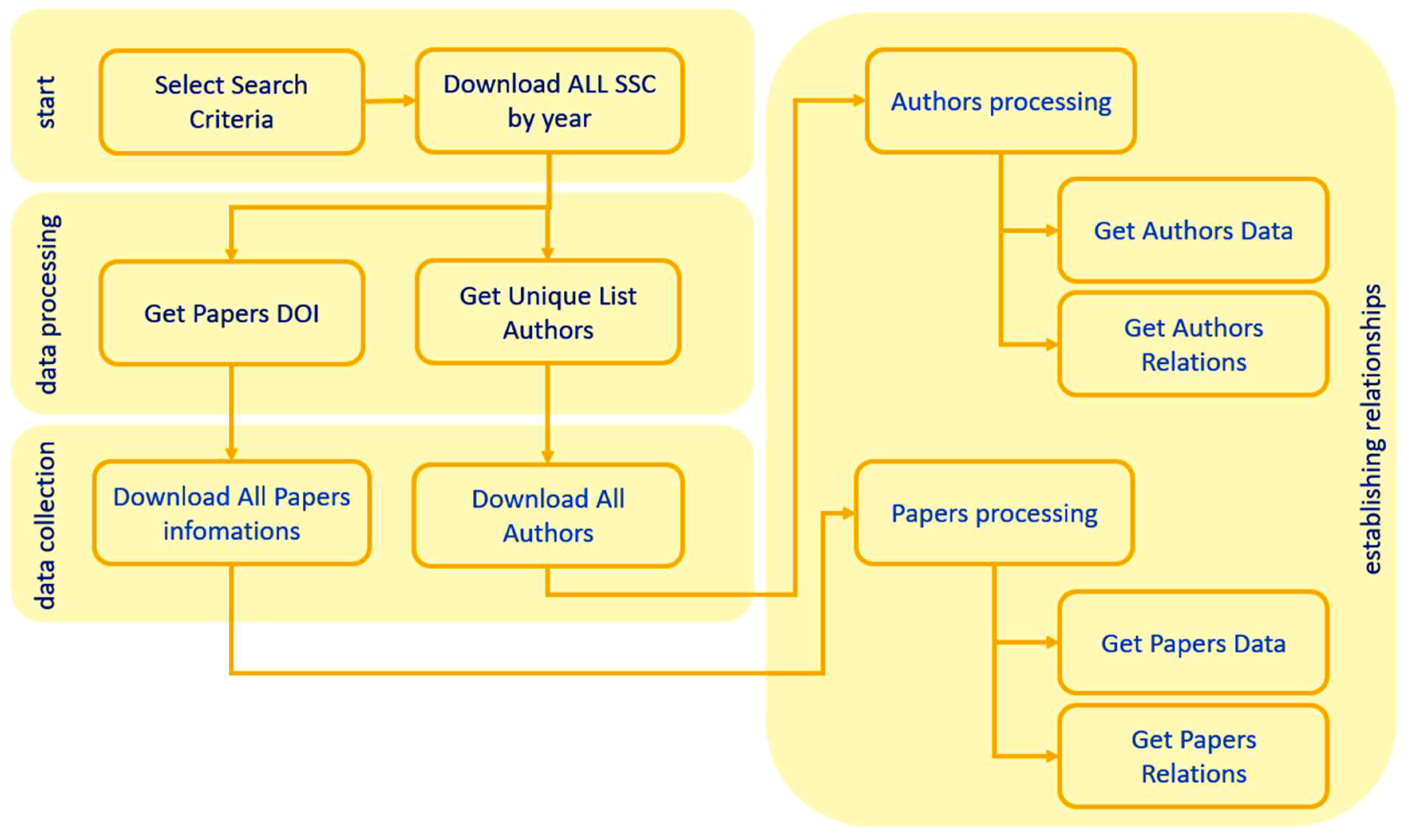
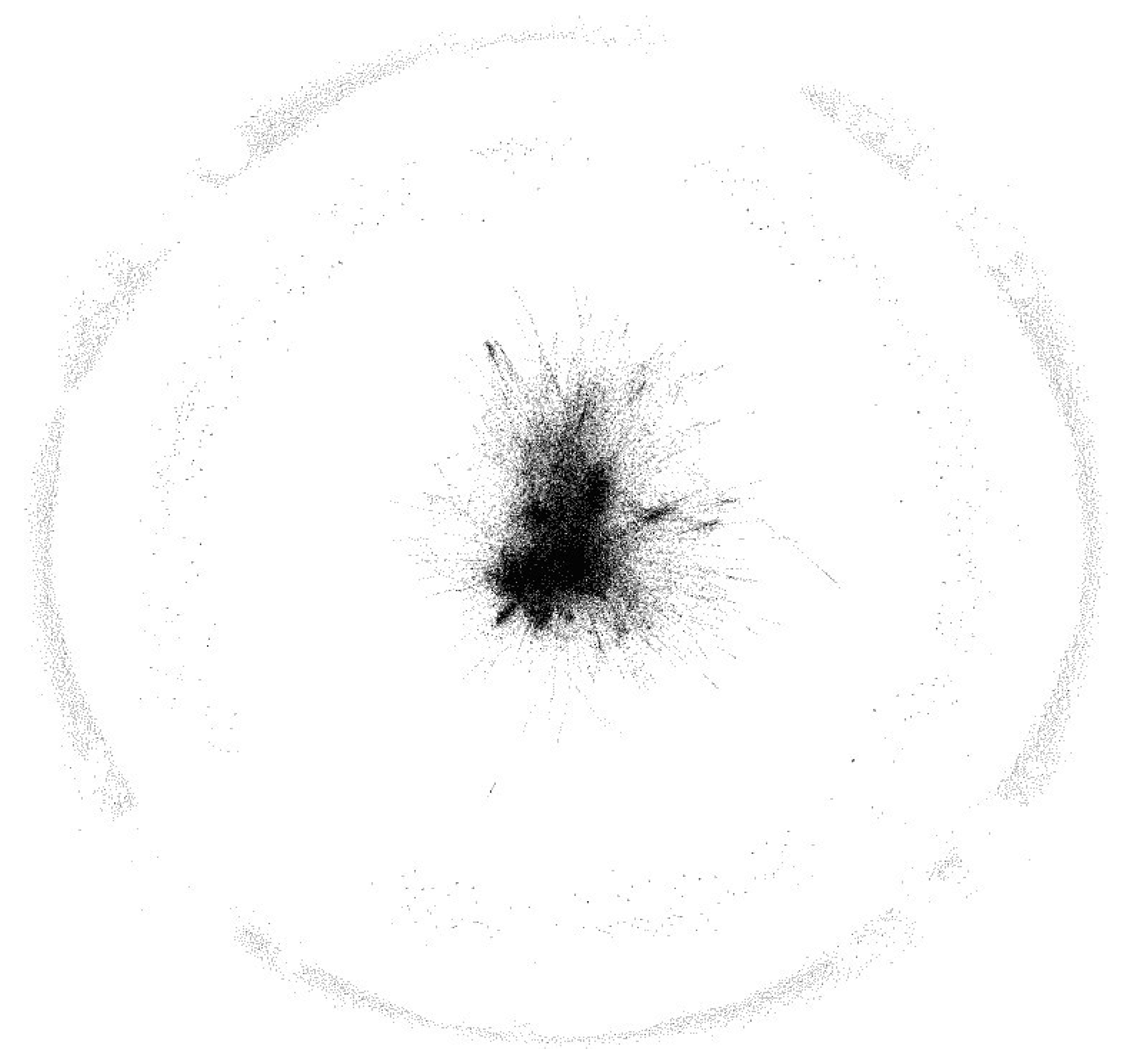
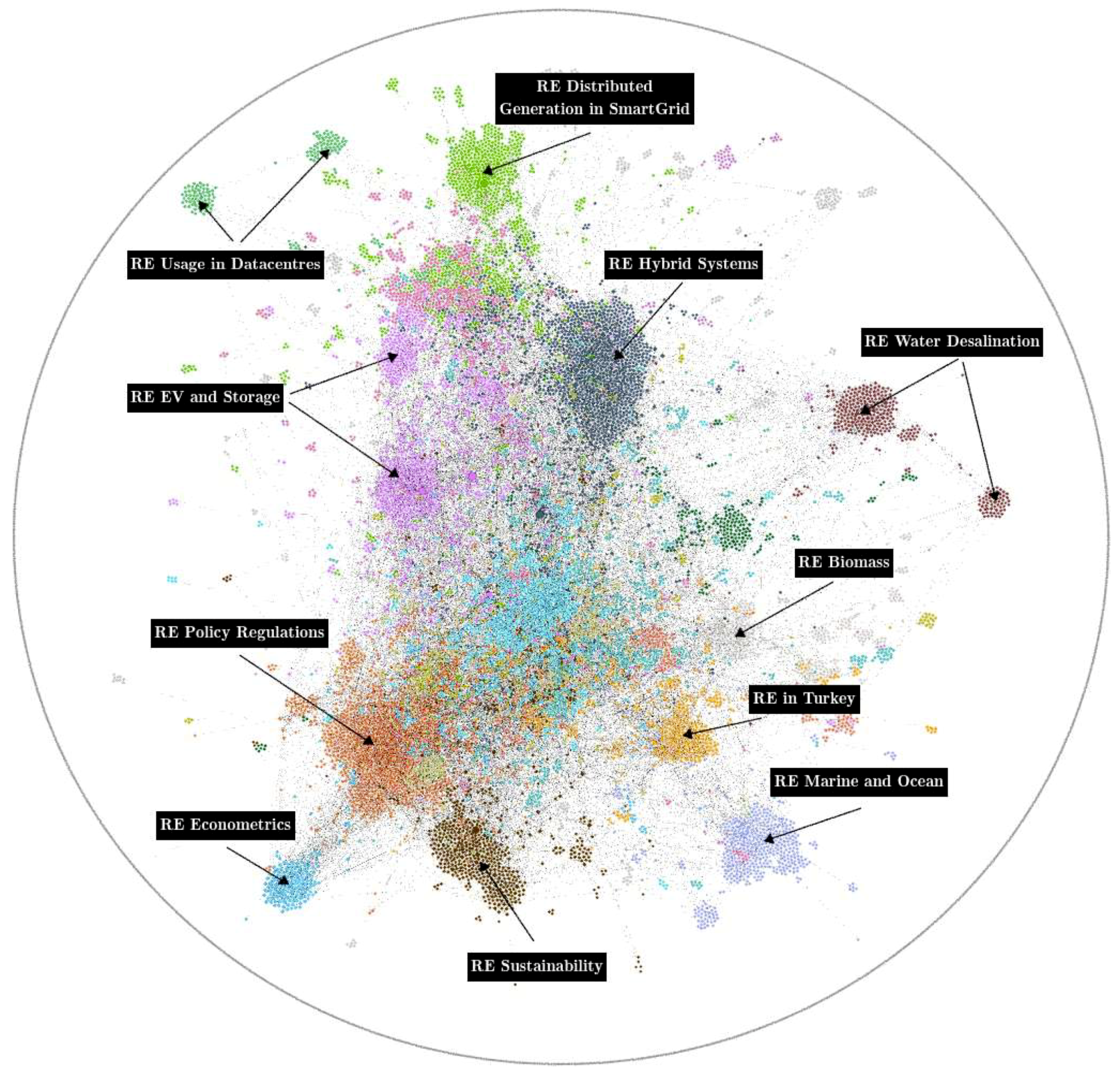

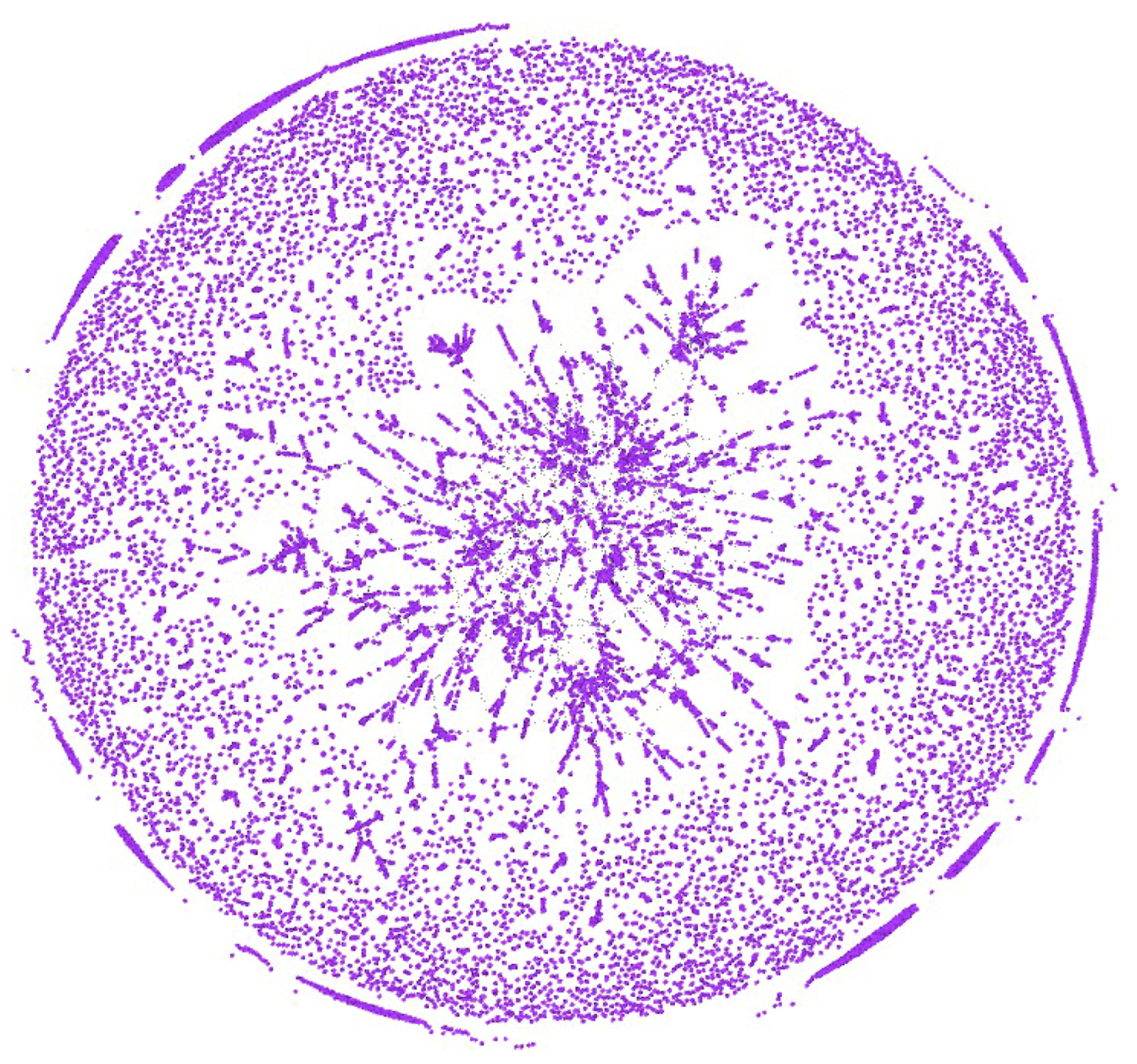


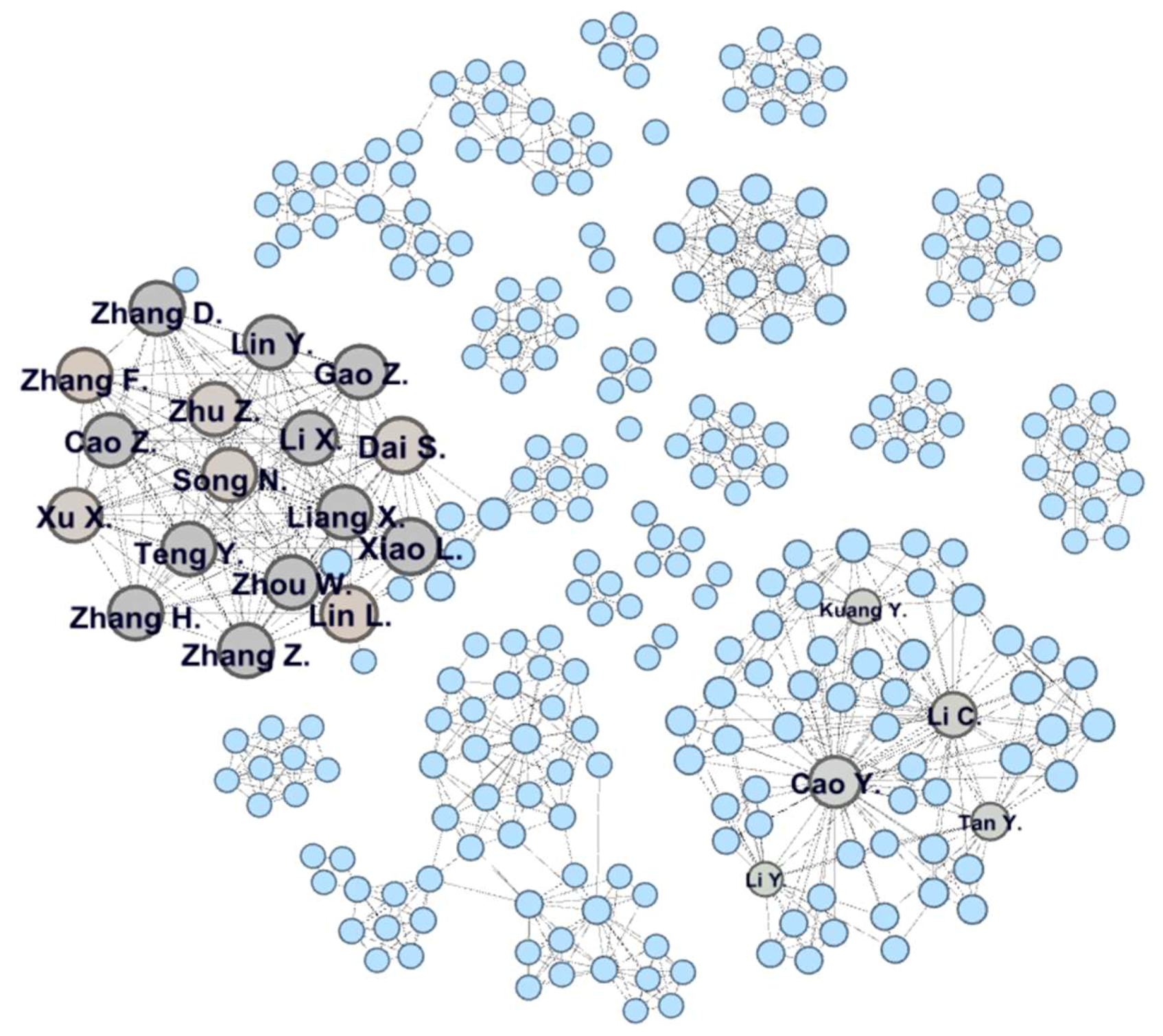

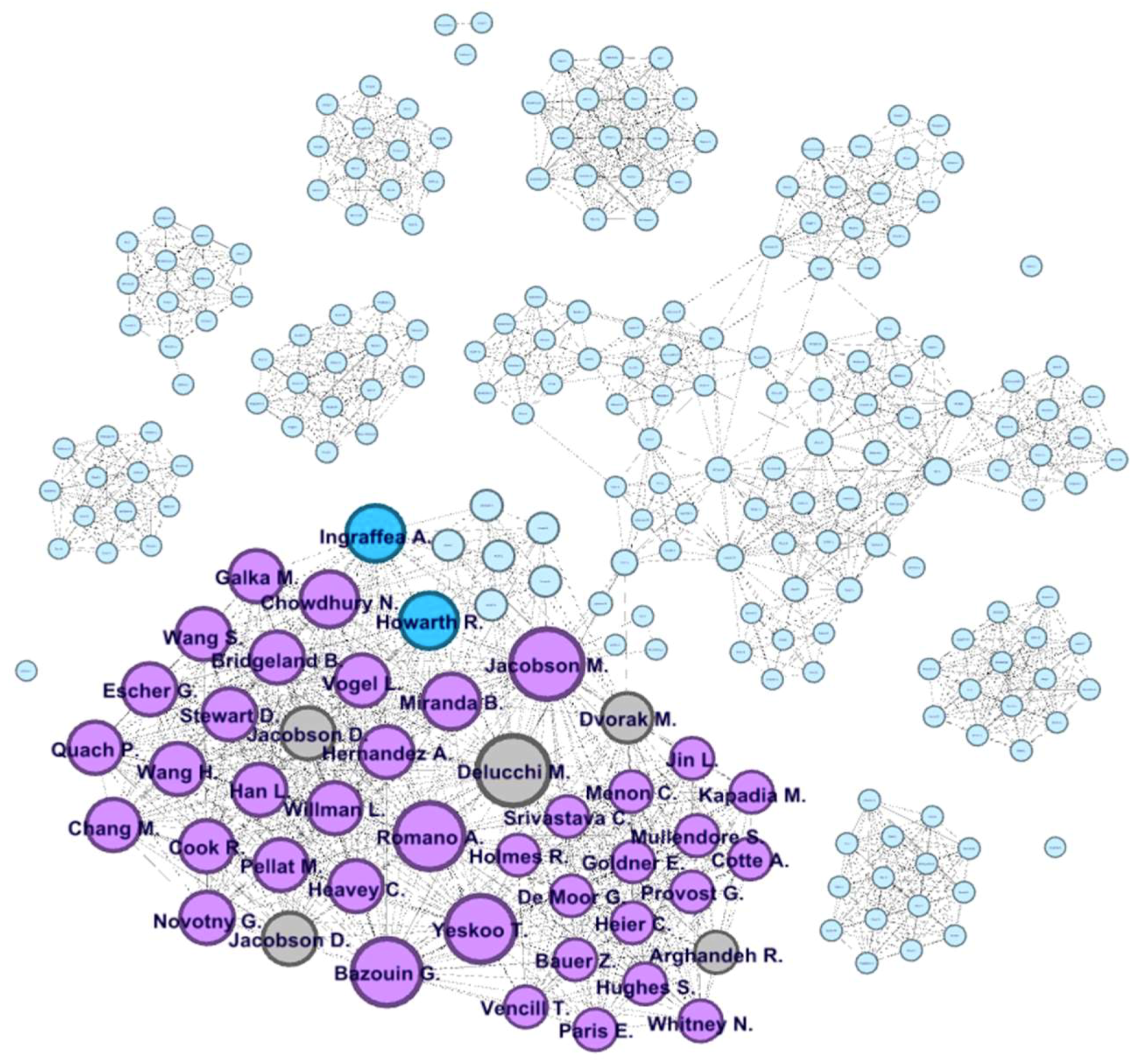
| Hybrid Systems | Electric Vehicle | Policy Regulations | Distributed Smart Grid Generation in | Sustainability | Usage in Data Centres | Economic Issues | Biomass | Marine and Ocean | Water Desalination | |
|---|---|---|---|---|---|---|---|---|---|---|
| 1 | Optimization | Smart grid | Feed-in tariff | Microgrid | Willingness to pay | Data center | Economic growth | Biomass | Wave energy | Desalination |
| 2 | Microgrid | Energy storage | Energy policy | Distributed generation | Sustainable development | Smart grid | Granger causality | Gasification | Wave power | Reverse osmosis |
| 3 | Fuel cell | Electric vehicle | Climate change | Smart grid | Energy policy | Energy efficiency | Sustainable development | Biodiesel | Tidal energy | Solar energy |
| 4 | Hybrid system | Optimization | Energy efficiency | Energy storage | Social acceptance | Cloud computing | Biomass | Malaysia | Ocean energy | Photovoltaic |
| 5 | Hydrogen | Distributed generation | Renewable portfolio standard | Power quality | Sustainability | Power management | CO2 emissions | Biogas | Tidal power | Pressure retarded osmosis |
| 6 | HOMER | Microgrid | Real options | Optimization | Contingent valuation | Green communications | Energy consumption | Biofuels | Environmental impact | Wind energy |
| 7 | Energy storage | District heating | Electricity | Distributed generation (DG) | Climate change | Microgrid | Nuclear energy | Palm oil | Offshore wind | Salinity gradient power |
| 8 | Distributed generation | Demand response | Electricity market | Energy storage system | Energy transition | Energy storage | Energy efficiency | Energy efficiency | Wave energy converter | Reverse electrodialysis |
| 9 | Hybrid power system | Energy efficiency | Innovation | Power electronics | Attitudes | Energy harvesting | Solar energy | Anaerobic digestion | Power generation | Wind power |
| 10 | Hybrid energy system | Energy system analysis | China | Demand response | Community | Green computing | Growth | Energy policy | Hydropower | Solar pond |
| 11 | Smart grid | Demand side management | Sustainability | Fuel cell | Energy efficiency | Scheduling | Panel cointegration | Feed-in tariff | Environmental impact assessment | Optimization |
| 12 | Electrolyzer | Hydrogen | European Union | Power systems | Planning | Battery | China | Sustainability | Wave energy converters | Geothermal energy |
| 13 | Energy management | Vehicle to grid | Tradable green certificates | Battery energy storage system | NIMBY | Sustainability | Panel data | Energy | Offshore wind energy | Seawater |
| 14 | Simulation | Electricity market | Policy | DC-DC converter | Education | Cellular networks | Miscanthus | Pyrolysis | Climate change | Energy recovery |
| 15 | Rural electrification | V2G | Germany | Battery | Participation | Lyapunov optimization | Trade | Hydrogen | Tidal | Brackish water |
| Journal Name | # Papers | Quota (%) |
|---|---|---|
| Renewable and Sustainable Energy Reviews | 1300 | 9.35 |
| Renewable Energy | 885 | 6.37 |
| Energy Policy | 814 | 5.86 |
| Energy | 431 | 3.10 |
| Applied Energy | 335 | 2.41 |
| International Journal of Hydrogen Energy | 206 | 1.48 |
| Energy Conversion and Management | 195 | 1.40 |
| Biomass and Bioenergy | 117 | 0.84 |
| Journal of Cleaner Production | 110 | 0.79 |
| Energy Economics | 108 | 0.78 |
| Energy and Buildings | 102 | 0.73 |
| Energies | 95 | 0.68 |
| Desalination | 94 | 0.68 |
| Solar Energy | 87 | 0.63 |
| International Journal of Renewable Energy Research | 84 | 0.60 |
| Conference/Proceedings Name | # Papers | Quota (%) |
|---|---|---|
| Energy Procedia | 312 | 3.97 |
| IEEE Power and Energy Society General Meeting | 232 | 2.96 |
| IET Conference Publications | 123 | 1.57 |
| Proceedings of the Universities Power Engineering Conference | 96 | 1.22 |
| ASEE Annual Conference and Exposition Conference Proceedings | 93 | 1.18 |
| International Conference on the European Energy Market, EEM | 86 | 1.10 |
| IECON Proceedings (Industrial Electronics Conference) | 72 | 0.92 |
| World Renewable Energy Forum, WREF | 71 | 0.90 |
| IFAC Proceedings Volumes (IFAC-PapersOnline) | 69 | 0.88 |
| European Conference on Power Electronics and Applications, EPE-ECCE Europe | 63 | 0.80 |
| Asia-Pacific Power and Energy Engineering Conference, APPEEC | 61 | 0.78 |
| European Conference on Power Electronics and Applications, EPE | 61 | 0.78 |
| Procedia Engineering | 55 | 0.70 |
| International Conference on Renewable Energy Research and Applications, ICRERA | 52 | 0.66 |
| IEEE Energy Conversion, Congress and Exposition, ECCE | 49 | 0.62 |
© 2018 by the authors. Licensee MDPI, Basel, Switzerland. This article is an open access article distributed under the terms and conditions of the Creative Commons Attribution (CC BY) license (http://creativecommons.org/licenses/by/4.0/).
Share and Cite
Alcayde, A.; G. Montoya, F.; Baños, R.; Perea-Moreno, A.-J.; Manzano-Agugliaro, F. Analysis of Research Topics and Scientific Collaborations in Renewable Energy Using Community Detection. Sustainability 2018, 10, 4510. https://doi.org/10.3390/su10124510
Alcayde A, G. Montoya F, Baños R, Perea-Moreno A-J, Manzano-Agugliaro F. Analysis of Research Topics and Scientific Collaborations in Renewable Energy Using Community Detection. Sustainability. 2018; 10(12):4510. https://doi.org/10.3390/su10124510
Chicago/Turabian StyleAlcayde, Alfredo, Francisco G. Montoya, Raul Baños, Alberto-Jesús Perea-Moreno, and Francisco Manzano-Agugliaro. 2018. "Analysis of Research Topics and Scientific Collaborations in Renewable Energy Using Community Detection" Sustainability 10, no. 12: 4510. https://doi.org/10.3390/su10124510






